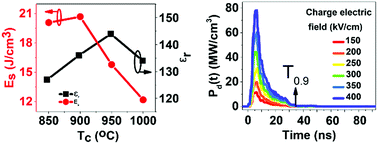Ultrahigh energy storage density and instantaneous discharge power density in BaO–PbO–Na2O–Nb2O5–SiO2–Al2O3 glass-ceramics
Abstract
Compared with traditional dielectric materials, ferroelectric glass-ceramic capacitors have higher energy storage densities and faster discharge speeds. In this study, 21.6BaO–2.4PbO–6Na2O–30Nb2O5–10Al2O3–30SiO2 glass-ceramics and their single-layer capacitors were successfully prepared. A maximum energy storage density of 20.7 J cm−3 was obtained in these glass-ceramics. For glass-ceramics capacitors crystallized at 900 °C, under an electric field of 400 kV cm−1, the maximum instantaneous power density reached was 78.2 MW cm−3 and the discharge time was <35 ns. The effects of crystallization temperature on dielectric energy storage properties were illustrated by investigating the crystallization kinetics, phase evolution, and microstructure of these glass-ceramics. The crystallization process was mainly affected by the bonding strengths of Si–O and Al–O. When the crystallization temperature increased from 850 to 1000 °C, crystallinity increased from 64.5 to 97.3%, Ba2NaNb5O15 and NaNbO3 were precipitated in all samples, and microstructural pores and microcracks gradually appeared. All the results showed that these materials were promising candidates for application in pulse capacitors.



 Please wait while we load your content...
Please wait while we load your content...